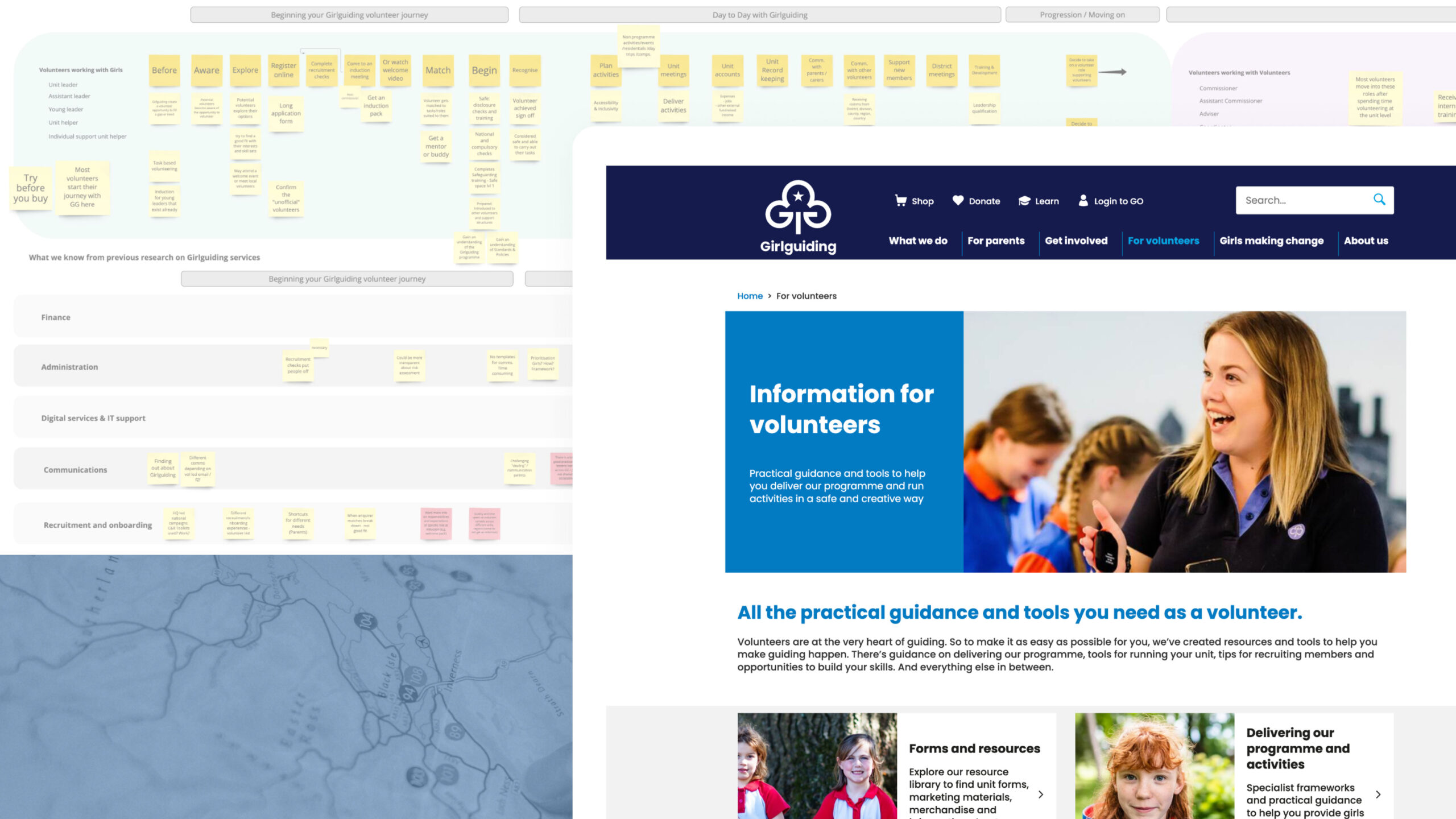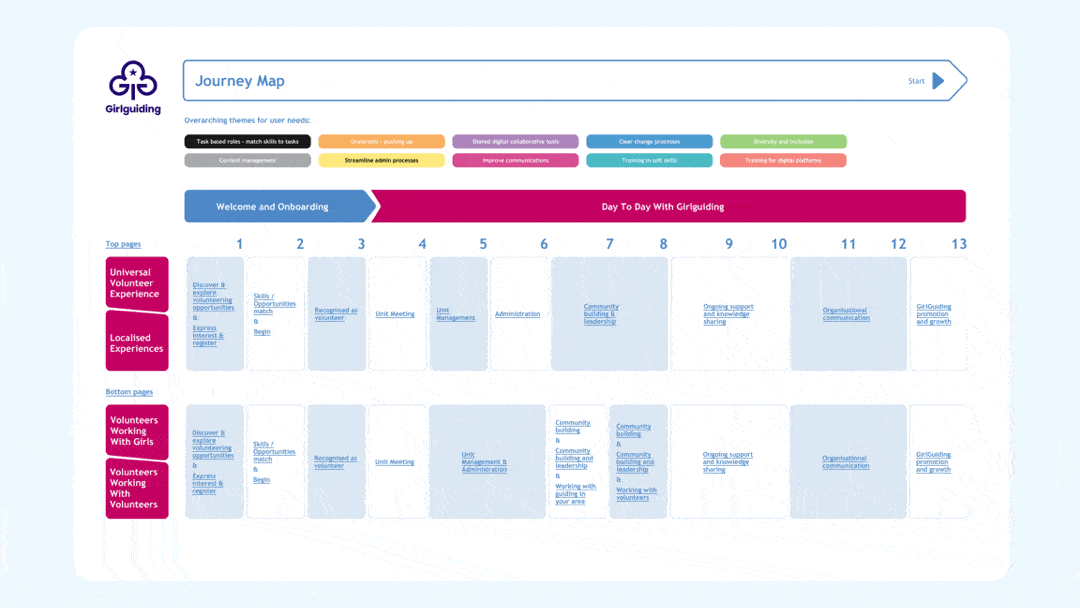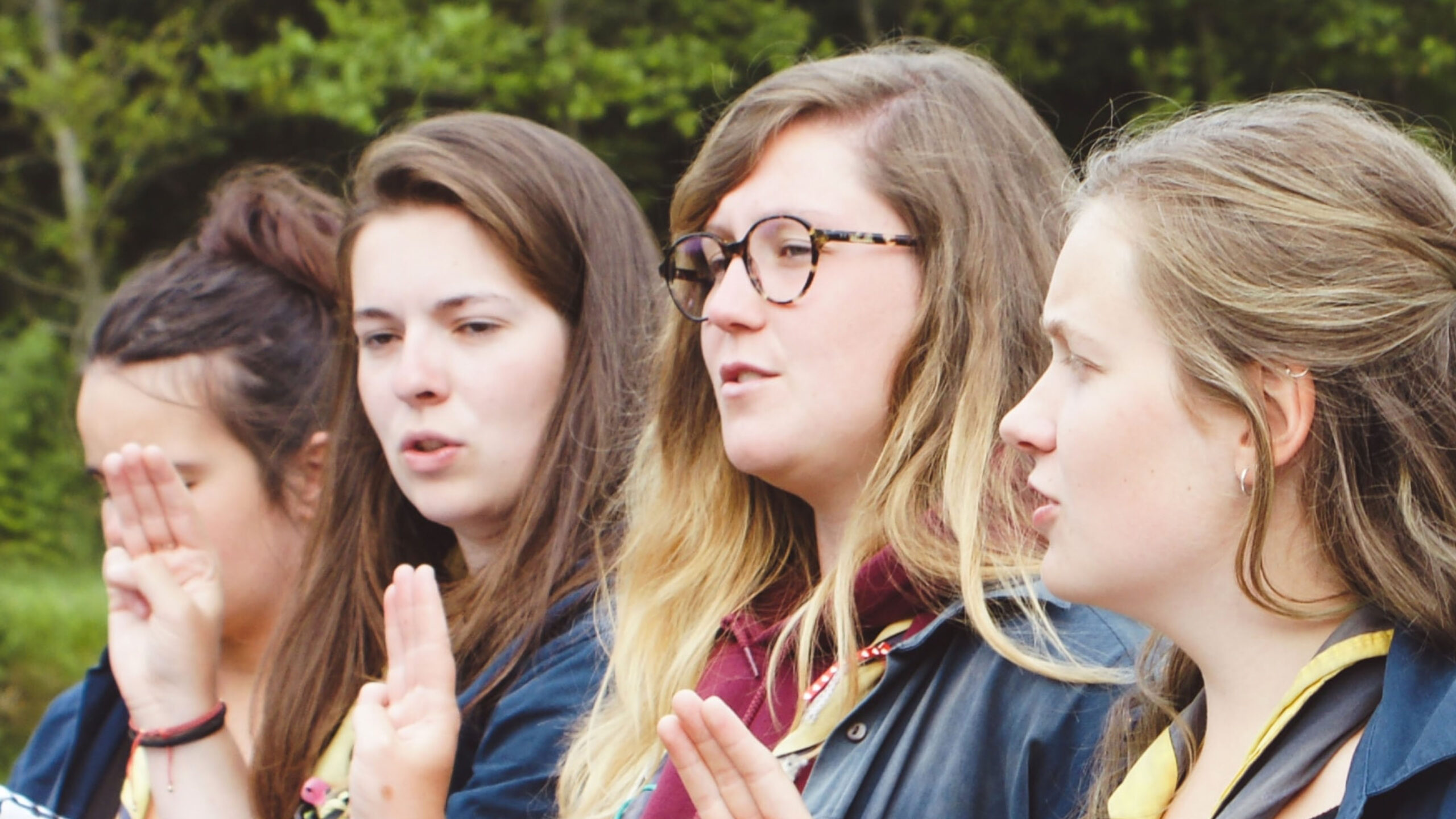For over a hundred years, Girlguiding has been empowering girls and showing them that whoever they are, wherever they’re from – they can do anything. But without the help of its volunteers, this work would not be possible.
That’s why Girlguiding wanted to transform the volunteer experience. However, before they could do that, they had to understand the volunteer lifecycle and experience, inside and out.
Girlguiding also needed research driven recommendations to help support a paradigm shift in the volunteer experience, as well as gain stakeholder buy-in. This is where Nomensa comes in.
Untangling complex processes
We’ve been working with Girlguiding since 2019. For this latest phase in our partnership, we used service design to:
- establish a holistic view and shared understanding of the ‘as is’ volunteer lifecycle and experience
- develop the ideal, ‘to be’ volunteer experience, driven by a united volunteer vision
- define and visualise the processes, infrastructure and systems that supported and delivered the experience
- create a service Blueprint that visually laid out and communicated the end-to-end volunteer experience.
- identify how all the different elements interconnected and interacted with one another and the broader Guiding organisation
Service design helped us to visualise the complex interactions that happen across Girlguiding, both internally and externally. It untangled the complex web of processes, digital and physical estates, tools and teams, and converted them into accessible, strategic assets.
Mapping out the volunteer experience
We began by reviewing Girlguiding’s extensive research library, compiling their internal research and reports involving the volunteer experience. From here, we generated an initial ‘as is’ volunteer journey map which included:
- volunteer activities across the end-to-end lifecycle with GirlGuiding.
- Pain points and what works well within that lifecycle
- who volunteers interacted with from Girlguiding (for example, finance, administration, digital services, IT and communication teams)
We then ran collaborative vision setting workshops with different internal departments. This helped us generate themes for the volunteer experience’s ‘to be’ vision.
We found that Girlguiding wanted to foster a more connected and inclusive community while streamlining its digital processes to support volunteer activities. We then worked together to understand the barriers we had, as well as what currently worked well and what could push us forward.
From here, we were able to identify six key priorities for the end-to-end volunteer journey:
- individual fulfilment
- community
- breaking down organisational barriers
- knowledge sharing
- digital channels
- onboarding

Co-mapping stakeholder workshops and research sessions
We held co-mapping interview sessions with volunteers with different roles and time spent volunteering with Girlguiding. In these sessions, we worked in the online collaborative platform, Miro, on a lo-fidelity journey map of the volunteer experience.
Using Miro meant volunteers could edit, evolve and enrich the journey map with user-driven insights. This gifted us with a detailed and nuanced understanding of the volunteer experience.
We ran similar co-mapping workshops and research sessions with key stakeholders across departments at Girlguiding, using the iterated ‘as is’ volunteer journey map. These sessions helped identify concrete solutions, pathways to change or more detailed follow up questions.
The work with volunteers and the Girlguiding team was consolidated to create a service blueprint. This included a series of swim lanes which showcased the holistic volunteer journey through a number of different viewpoints.
Service design as a strategic advantage
By using the collaborative design platform, Figma, we were able to give Girlguiding an interactive, living service blueprint. Rather than having a flat snapshot in time, it enabled GirlGuiding to update and evolve the service as work is proposed and completed.
The interactive nature of the service blueprint also allowed the team to interrogate the map at a higher strategic level, as well as draw out more in-depth patterns to help direct more detailed improvement work.
For example, the ‘as is’ volunteer journey swim lane was tagged with overarching themes for user needs, and the service design swim lane was tagged with overarching themes for experience improvements. These could be used interactively to spotlight specific themes across the map.
Our impact
By considering more in-depth patterns and clusters of these themed tags we were able to better understand:
- when and where multi-departmental teams should be involved
- where there may be dependencies for improvement work across the service
- where improvements might have the biggest impact for volunteers
- where there may be too many or too few resources or improvements based on user needs
This service blueprint provided a holistic view of their service, mapping the possible all in one place. It also:
- supported a cultural shift by unifying stakeholders around insights
- put volunteer needs top and centre by highlighting lived experience
- acted as a strategic guidepost and decision-making tool, changing and growing alongside its ‘to be’ vision
- provided a roadmap for Girlguiding to best support their dedicated force of volunteers
This work helped Girlguiding prioritise their next steps of work, leveraging user-driven insights as they continue to put into practice their wider strategy to transform their volunteer experience.

Work with us
A big part of transforming any service is to understand where your current service stands and where and how improvements can be made. A Service blueprint can be an invaluable asset to understand both your users and your organisational needs and processes, and how they work hand in hand.
So, if you’re interested in using service design to unlock your organisation’s potential, get in touch.

